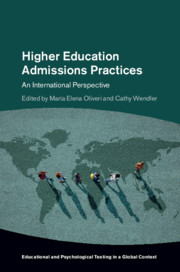Book contents
- Higher Education Admissions Practices
- Educational and Psychological Testing in a Global Context
- Higher Education Admissions Practices
- Copyright page
- Contents
- Figures
- Tables
- Contributors
- Series Editor’s Foreword
- Foreword
- Acknowledgments
- Part I Global Challenges and Common Admissions Models
- Chapter 1 An Overview of Higher Education Admissions Processes
- Chapter 2 Comparing College Aspirations across PISA Countries: Are 17 Percent Oranges Less than 75 Percent Apples?
- Chapter 3 Merit-Based Admissions in Higher Education
- Chapter 4 The Open Admissions Model: An Example from the United States
- Chapter 5 Character-Based Admissions Criteria in the United States and in Europe: Rationale, Evidence, and Some Critical Remarks
- Chapter 6 Cross-Cultural and Global Competencies and Their Role in Admissions Policies and Practices
- Part II Country-Specific Admissions Practices
- Part III Assessments Used in Higher Education Admissions
- Part IV Rethinking Higher Education Admissions
- Index
- References
Chapter 5 - Character-Based Admissions Criteria in the United States and in Europe: Rationale, Evidence, and Some Critical Remarks
from Part I - Global Challenges and Common Admissions Models
Published online by Cambridge University Press: 09 January 2020
- Higher Education Admissions Practices
- Educational and Psychological Testing in a Global Context
- Higher Education Admissions Practices
- Copyright page
- Contents
- Figures
- Tables
- Contributors
- Series Editor’s Foreword
- Foreword
- Acknowledgments
- Part I Global Challenges and Common Admissions Models
- Chapter 1 An Overview of Higher Education Admissions Processes
- Chapter 2 Comparing College Aspirations across PISA Countries: Are 17 Percent Oranges Less than 75 Percent Apples?
- Chapter 3 Merit-Based Admissions in Higher Education
- Chapter 4 The Open Admissions Model: An Example from the United States
- Chapter 5 Character-Based Admissions Criteria in the United States and in Europe: Rationale, Evidence, and Some Critical Remarks
- Chapter 6 Cross-Cultural and Global Competencies and Their Role in Admissions Policies and Practices
- Part II Country-Specific Admissions Practices
- Part III Assessments Used in Higher Education Admissions
- Part IV Rethinking Higher Education Admissions
- Index
- References
Summary
In this chapter, we discuss the rationale, practice, evidence, and effects of character-based college admissions from both a US and a European perspective. With the increasing globalization, it is important to discuss and evaluate recent developments with respect to selective college admissions. This chapter discusses the rationale for implementing character-based admission criteria in admission testing, admission practices in several European countries, the empirical evidence of the validity and fairness of character-based admission tools, and how academic- and character-based admission criteria are combined.
Keywords
- Type
- Chapter
- Information
- Higher Education Admissions PracticesAn International Perspective, pp. 76 - 95Publisher: Cambridge University PressPrint publication year: 2020

